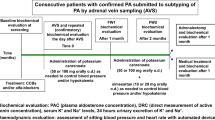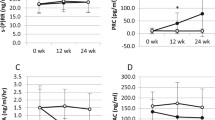Summary
The influence of ACTH, angiotensin II, orthostasis and hemodialysis on plasma aldosterone concentration was investigated in 14 anephric patients. Furthermore, plasma renin activity (PRA), plasma cortisol, plasma sodium concentration and plasma potassium concentration were measured.
After infusion of synthetic ACTH (2.5 εg/min Synacthen) for 4 h a significant rise of plasma aldosterone concentration and plasma cortisol concentration was observed (p<0.025,p<0.005, respectively), whereas serum sodium and serum potassium concentrations remained unchanged.
A slight though not statistically significant rise of plasma aldosterone concentrations was observed after 1 h-infusion of synthetic angiotensin II (1.0 ng/kg/min Hypertensin) while plasma cortisol concentration and serum electrolytes showed only minor changes. Sixty min after starting the infusion with angiotensin II ACTH (2.5 µg/min Synacthen) was infused additionally over a period of 4 h. Under the latter conditions as with ACTH alone an increase of plasma aldosterone concentration was observed.
Orthostasis caused a significant rise in plasma aldosterone (p<0.05), whereas plasma cortisol and the serum electrolytes remained unchanged.
Conventional as well as isonatriaemic and isokaliaemic hemodialysis let to a comparable increase of plasma aldosterone. Plasma cortisol was unchanged during conventional hemodialysis, and showed a decrease after isonatriaemic and isokaliaemic hemodialysis.
With a few exceptions plasma renin activity (PRA) was undetectable low (<0.2 ng/ml·3 h). In those instances where low normal PRA values were found, these values were not influenced by hemodialysis or orthostasis.
Our results show that in anephric patients plasma aldosterone increased in response to synthetic ACTH, orthostasis and hemodialysis. After the infusion of angiotensin II only a slight, statistically not significant increase in plasma aldosterone concentration was observed. The simultaneous infusion of ACTH and angiotensin II let to a comparable increase in plasma aldosterone as ACTH alone.
Furthermore, hemodialysis let to an increase of plasma aldosterone under conventional as well as under isokaliaemic and isonatriaemic conditions. These changes in hormone concentration as well as those induced by orthostasis could not be explained by one of the known aldosterone stimulating factors. Thus, our findings suggest that other factors may be involved in the regulation of plasma aldosterone in anephric man.
Zusammenfassung
Bei 14 anephrischen Patienten wurde der Einfluß von ACTH, Angiotensin II, Orthostase und Hämodialyse auf die Plasmaaldosteronkonzentration untersucht. Gleichzeitg wurden Plasmareninaktivität (PRA), Plasmacortisol, Serumnatrium und Serumkalium bestimmt.
Unter 4stündiger Infusion von synthetischem ACTH (2,5 µg/min Synachten) kam es zu einem signifikanten Anstieg des Plasmaaldosterons und des Plasmacortisols (p<0,025 bzw. <0,005), während Serumnatrium und Serumkalium unverändert blieben.
Eine einstündige Infusion einer suppressorischen Dosis von synthetischem Angiotensin II (1,0 ng/kg Körpergewicht/min Hypertensin) führte zu einem geringgradigen, jedoch nicht signifikanten Anstieg des Plasmaaldosterons und hatte keinen Einfluß auf Plasmacortisol und Serumelektrolyte. Eine nach 60 min zusätzlich durchgeführte ACTH-Infusion (2,5 µg/min Synacthen) bewirkte über einen Zeitraum von 4 h einen ähnlichen Plasmaaldosteronansteig wie die alleinige ACTH-Infusion.
Durch Orthostase ließ sich ein signifikanter Anstieg des Plasmaaldosterons (p<0,05) erzielen, während Plasmacortisol und Serumelektrolyte keine signifikanten Veränderungen zeigten.
Sowohl normale als auch isonatriämische und isokaliämische Hämodialyse führten zu einem vergleichbaren Anstieg des Plasmaaldosterons. Das Plasmacortisol blieb bei der normalen Hämodialyse unverändert und fiel bei der isonatriämischen und isokaliämischen Hämodialyse ab.
Die Plasmareninaktivität war unter den beschriebenen Versuchsbedingungen mit ganz wenigen Ausnahmen nicht meßbar (<0,2 mg/ml·3 h). Vereinzelt tiefnormale PRA-Werte wurden weder durch Hämodialyse noch Orthostase beeinflußt.
Unsere Ergebnisse zeigen bei nierenlosen Patienten eine Stimulation des Plasmaaldosterons durch synthetisches ACTH, ein geringgradiges Ansprechen auf suppressorisches Angiotensin II, eine fehlende Potenzierung der ACTH-Wirkung durch suppressorische Dosen von Angiotensin II und einen Aldosteronanstieg unter Orthostase. Ferner ließ sich unter Hämodialyse ein Anstieg des Plasmaaldosterons beobachten. Dieser Anstieg trat sowohl unter normaler als auch unter isokaliämischer und isonatriämischer Hämodialyse auf und konnte deshalb ebenso wie die durch Orthostase induzierte Veränderung der Hormonkonzentration keinem der bekannten aldosteronstimulierenden Faktoren zugeordnet werden. Eine mögliche Beteiligung anderer Faktoren an der Aldosteronregulation ist deshalb anzunehmen.
Similar content being viewed by others
Literatur
Balikian HM, Brodie AH, Dale SL, Melby JD, Tait JF (1968) Effect of posture on the metabolic clearance rate, plasma concentration and blood production rate of aldosterone in man. J Clin Endocrinol 28:1630
Bayard F, Cooke CR, Tiller DJ, Beitins IZ, Kowarski A, Walker WG, Migeon CJ (1971) The regulation of aldosterone secretion in anephric man. J Clin Invest 50:1585
Berman LB, Vertes V, Mitra S, Gould AB (1972) Renin-angiotensin system in anephric patients. N Engl J Med 286:58
Capelli JP, Wesson LG, Aponte GE, Faraldo C, Jaffe E (1968) Characterisation and source of a renin-like enzyme in anephric humans. J Clin Endocrinol 28:221
Cooke CR, Ruiz-Maza F, Kowarski A, Migeon CJ, Walker WG (1973) Regulation of plasma aldosterone concentration in anephric man and renal transplant recipients. Kidney Int 3:160
Davis JO, Binnion PF, Brown TC, Johnston CI (1966) Mechanisms involved in the hypersecretion of aldosterone during sodium depletion. Circ Res 18–19:[Suppl I] 1–43
Deheneffe J, Cuesta V, Briggs JD, Brown JJ, Fraser R, Lever AF, Morton JJ, Robertson JIS, Tree M (1976) Response of aldosterone and blood pressure to angiotensin II infusion in anephric man. Effect of sodium deprivation. Circ Res 39:183
Deheneffe J, Cuesta V, Robertson I (1975) The control of aldosterone in anephric man. Clin Sci Mol Med 48:465
Ducrot H, Kleinknecht D, Jungers P (1970) Blood pressure, hemodynamics, renin and body fluid in renoprival man. In: Alwall N, Berglund F, Josephson B (eds), Proceedings of the Fourth International Congress of Nephrology, Stockholm 1969. Vol 2, Endocrinology, megabolic aspects. Karger, Basel, p 65
Epstein M, Sancho J, Perez G, Haber E, Re R, Loutzenhiser R (1978) Volume as a determinant of plasma aldosterone in anephric man. J Clin Endocrinol Metab 46:309
Ganten D, Hayduk K, Brecht HM, Boucher R, Genest J (1970) Evidence of renin release or production in splanchnic territory. Nature 226:551
Goodwin TJ, James VHT, Peart WS (1974) The control of aldosterone secretion in nephrectomized man. Clin Sci Mol Med 47:235
Haber E, Koerner T, Page LB, Kliman B, Purnode A (1969) Application of radioimmunoassay for angiotensin I to the physiologic measurements of plasma renin activity in normal human subjects. J Clin Endocrinol 29:1349
Laragh JH, Angers M, Kelly WG, Lieberman S (1960) Hypotensive agents and pressor substances. The effect of epinephrine, norepinephrine, angiotensin II and others on the secretory rate of aldosterone in man. J Am Med Assoc 174:96
Laragh JH, Sealey JE, Brunner HR (1974) The control of aldosterone secretion in normal and hypertensive man: abnormal renin-aldosterone patterns in low renin hypertension. In: Laragh JH (ed) Hypertension manual. Yorke Medical Books, p 197
McCaa RE, Young DB, Guyton AC, McCaa CS (1974) Evidence for a role of an unidentified pituitary factor in regulating aldosterone secretion during altered sodium balance. Circ Res 34–35:[Suppl I] 1–15
McCaa RE, Young DB, Bower JD, McCaa CS (1973) Stimulation of aldosterone secretion by sodium depletion in anephric man. Trans Am Soc Artif Intern Organs 19:287
McCaa RE, Bower JD, McCaa CS (1973) Relative influence of acute sodium and volume depletion on aldosterone secretion in nephrectomized man. Circ Res 33:555
McCaa RE, Read VH, Bower JD, McCaa CS, Guyton AC (1971) Adrenal cortical response to hemodialysis, ACTH and angiotensin II in anephric man. Circulation 43–44:[Suppl II] 2–67 (Abstract)
McCaa RE, Read VH, Cowley AW, Bower JD, Smith GV, McCaa CS (1973) Influence of acute stimuli on plasma aldosterone concentration in anephric man and kidney allograft recipients. Circ Res 33:313
McCaa RE, McCaa CS, Read VH, Bower JD (1972) Influence of hemodialysis on plasma aldosterone concentration in nephrectomized patients. Trans. Am Soc Artif Intern Organs 18:239
McCaa RE, McCaa CS, Read DG, Bower JD, Guyton AC (1972) Increased plasma aldosterone concentration in response to hemodialysis in nephrectomized men. Circ Res 31:473
McKenzie JK, Montgomerie JZ (1969) Rein-like activity in the plasma of anephric men. Nature 223:1156
Mitra S, Genuth SM, Berman LB, Vertes V (1972) Aldosterone secretion in anephric patients. N Engl J Med 286:61
Murphy BP, Engelberg W, Pattee CHJ (1963) Simple method for determination of plasma corticoids. J Clin Endocrinol Metab 23:293
Ølgaard K, Madsen S (1976) The influence of potassium and ACTH on plasma-aldosterone regulation in anephric patients. Proc Eur Dial Transplant Assoc 12:313
Ølgaard K (1975) Plasma aldosterone in anephric and non-nephrectomized dialysis patients in relation to changes in plasma potassium without change in total potassium balance. Acta Med Scand 198:213
Ølgaard K, Madsen S, Hammer M (1977) The adrenocortical response to angiotensin II infusion in anephric and non-nephrectomized patients on regular hemodialysis. Acta Med Scand 202:213
Ølgaard K, Madsen S, Ladefoged J, Regeur L (1977) Plasma aldosterone during extracellular fluid volume expansion in patients on regular haemodialysis. Eur J Clin Invest 7:61
Read VH, McCaa CS, Bower JD, McCaa RE (1973) Effect of hemodialysis on the metabolic clearance rate, plasma concentration and blood production rate of aldosterone in anephric man. J Clin Endocrinol Metab 36:773
Schlatmann RJAFM, Jansen AP, Prenen H, van der Korst JK (1964) The natriuretic and aldosterone-suppressive action of heparine and some related polysulfated polysaccharides. J Clin Endocrinol Metab 24:35
Symonds EM, Stanley MA, Skinner SL (1968) Production of renin by in vitro cultures of human chorion and uterine muscle. Nature 217:1152
Vetter W, Záruba K, Armbruster H, Beckerhoff R, Siegenthaler W (1975) Einfluß der Hämodialyse auf die Plasmaaldosteronkonzentration bei nierenlosen Patienten. Klin Wochenschr 53:17
Vetter W, Vetter H, Siegenthaler W (1973) Radioimmunoassay for aldosterone without chromatography. 2. Determination of plasma aldosterone. Acta Endocrinol (Kbh) 74:558
Vetter W, Záruba K, Armbruster H, Beckerhoff R, Reck G, Siegenthaler W (1974) Control of plasma aldosterone in supine anephric man. Clin Endocrinol 3:411
Weidmann P, Horton R, Maxwell MH, Franklin SS, Fichman M (1973) Dynamic studies of aldosterone in anephric man. Kidney Int 4:289
Weidmann P, Maxwell MH (1975) The renin-angiotensin-aldosterone system in terminal renal failure. Kidney Int 8:219
Weidmann P, Horton R, Franklin SS, Fichman M, Gral T, Maxwell MH (1972) Regulation of aldosterone in anephric man maintained with regular hemodialysis. Proc Eur Dial Transplant Assoc 9:74
Williams GH, Dluhy RG, Underwood RH (1970) The relationship of dietary potassium intake to the aldosterone stimulating properties of ACTH. Clin Science 39:489
Williams GH, Bailey GL, Hampers CL, Lauler DP, Merrill JP, Underwood RH, Blair-West JR, Coghlan JP, Denton DA, Scoggins BA, Wright RD (1973) Studies on the metabolism of aldosterone in chronic renal failure and anephric man. Kidney Int 4:280
Yu R, Anderton J, Skinner SL, Best JB (1972) Renin in anephric man. Case Report with physiologic studies. Am J Med 52:707
Author information
Authors and Affiliations
Rights and permissions
About this article
Cite this article
Tuma, J., Záruba, K., Studer, A. et al. Regulation der Plasmaaldosteronkonzentration bei nierenlosen Patienten. Klin Wochenschr 59, 27–34 (1981). https://doi.org/10.1007/BF01477327
Received:
Accepted:
Issue Date:
DOI: https://doi.org/10.1007/BF01477327




